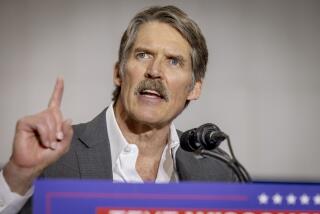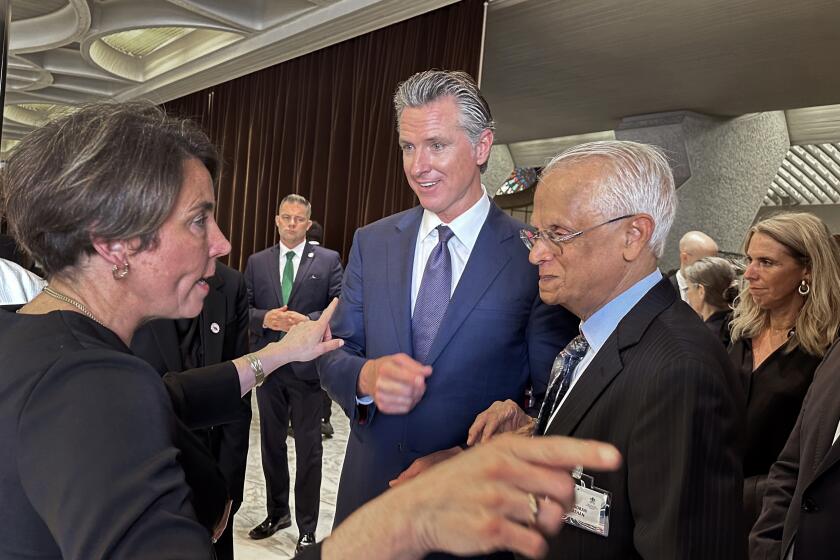Spending Limit: Straitjacket on Future of California
The Gann government spending limit, passed quietly seven years ago and little noticed until now, threatens to be a straitjacket on California’s future. It is so fundamentally flawed that pressure will eventually build to change it. But before the political will is marshaled to take on the “Spirit of 13,” it could do serious damage to the ability of state and local governments to function.
While attention is focused on Congress’ budget battles, the state faces its own self-imposed Gramm-Rudman measure, and California doesn’t even have a deficit.
The expenditure limit, placed in California’s Constitution in a special election in 1979, prevents state and local government spending from growing faster than the rate of inflation plus the rate of population growth in any year. Thus if inflation is 3% and population growth is 1%, all government spending--including education--can grow no more than 4% in that year.
The flaw in this formula is obvious: It makes no provision whatsoever for real economic growth. If there is any real economic growth that leads to increased revenues, those revenues cannot be spent on unmet needs or improved services, but must be returned to taxpayers. Increased revenues cannot even be spent to pay for increased costs of growth.
The result is that the budget process becomes a zero-sum game. No improvement in a program is possible unless the money comes from somewhere else. No new needs, such as toxics or child abuse, can receive funding unless some other program, such as education or transportation, loses out. No social or demographic change, such as an increasingly large aging population, can be responded to without cuts in other programs.
The effect of the Gann measure goes far beyond the Reagan Administration goal of keeping government spending at a constant percentage of the gross national product. In California, state and local government spending will not remain at constant percentage of income, but will be required to decline as a proportion of income, no matter what level of services may be needed and may be affordable.
Problems with the limit have already been felt to some degree on the local level. In Marin County and elsewhere, voters have had to pass overrides in order to be able to spend the revenues from commercial and industrial growth and from sales-tax collections. Local governments must continue to pass overrides just to keep up with the costs of growth and to maintain schools and services.
On the state level, the limit has had little effect until now, because historically high inflation pushed the limit up while severe recession kept revenues low. Now, after a period of real economic growth and low inflation, the state has quickly moved up to the limit. Next year, according to the Commission on State Finance, nearly $1 billion will have to be cut from current programs. The commission estimates that over the next nine years, regardless of state needs, a total of about $30 billion of normally anticipated spending on basic functions would have to be eliminated.
Because there are loopholes in the measure, the game in Sacramento now is how to get around the Gann limit. Tax loopholes are regaining popularity. Special-interest tax breaks, which the Legislature ordinarily would reject, are being justified because “we can’t spend the money anyway.” Programs financed by user fees are not subject to the limit, so the transportation lobby wants a constitutional amendment on the November ballot to exempt highways by calling the gas tax a user fee. Bond obligations are exempt, so short-term bonds, secured by the expected revenues from growth, are being considered for funding normal program operations. One proposal even suggests a large refundable tax credit to teachers to pay for education without offending the limit.
And there will be other Gann avoidance ploys, not because government is full of “big spenders” but because the limit is so unworkable. Public finance will become a patchwork of gimmicks to avoid an arbitrary limit, at great cost to government efficiency and effectiveness. If ordinary taxpayers think that they will benefit from this process, they had better think again.
There is a partial solution, short of eliminating the limit, that should be broadly acceptable. Currently, Article XIII-B lets government grow at the rate of inflation or the growth of per-capita personal income, whichever is less . If this formula were turned around to be whichever is greater , revenues from growth could be spent.
This modest change has been suggested for inclusion in the pending constitutional amendment proposed for transportation. But so far such a proposal has been rejected because real damage has not yet been felt. As is so often the case in the political process, foresight does not provoke action. Blood will have to flow before politicians take on even this weakest link in the sacred texts of the tax revolt. And it will flow, from vital public services in the coming years, unless this fundamental obstacle to reasonable government is addressed.
More to Read
Get the L.A. Times Politics newsletter
Deeply reported insights into legislation, politics and policy from Sacramento, Washington and beyond. In your inbox three times per week.
You may occasionally receive promotional content from the Los Angeles Times.






